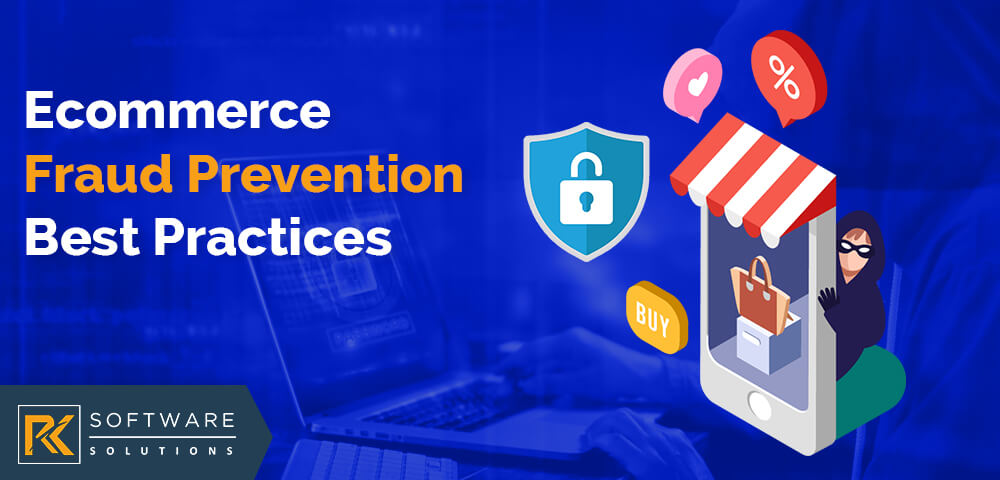
July 27, 2024
Ecommerce Fraud Prevention Best Practices
No matter how many clients you have, scammers will target your website. You are responsible for protecting not only your company but also that of your customers from fraud. If you do, you risk losing money, clients, and reputation. The rise in popularity of ecommerce has also been accompanied by a rise in online fraud and cybercrime. Online retailers experienced an average of 824 attempted fraud attacks monthly, which more than doubled in 2022. In this article, we will look into Ecommerce fraud prevention best practices.
What is Ecommerce Fraud?
Ecommerce fraud is a type of criminal activity for a financial benefit that impacts the commercial transactions happening on the internet. In this process, the merchant and the customer both lose money. The customer’s identity or card data gets stolen, but their money is safe. Merchants are responsible for the costs associated with fraudulent purchases.
How Does Ecommerce Fraud Occur?
Ecommerce fraud occurs as a result of criminals being opportunistic. Ecommerce fraud can be committed by spammers both offline and online. In both cases, the criminals use computers or other internet-connected electronic equipment, such as point-of-sale hardware or online payment systems.
Even though there are many different varieties of ecommerce fraud, they are all variants on one of the following themes.
- Data scraping: Collecting and selling information from a website to another scammer.
- Phishing: Sending malicious emails or text messages to the users who are talking to them and stealing their payment data.
- Malware: Installing malicious software on a customer’s computer which absorbs all the customer’s personal data.
Cybercriminals often use a combination of these methods and steal customers’ information.
Types of Ecommerce Fraud
1. Friendly Fraud
Approximately 39% of the frauds are friendly frauds. Friendly fraud means when a customer buys any product through an ecommerce website and files a chargeback with their bank. Customers claim that their product is different from what they placed an order for, an Undelivered product, or the order gets cancelled after payment.
2. Card Testing Fraud
It is the second most popular type of fraud run by scammers. Scammers use the stolen card to make purchases and see whether it is working; if the card works, they will go for an expensive purchase using the stolen card. Due to this, most of your online payments will be blocked, and extra charges and disputes to be faced by the company.
3. Refund Abuse
Customers who return broken, damaged, or stolen goods to a shop in exchange for a refund is said to be refund abuse. Even though many retailers have strict return policies determining the terms and conditions for a refund, it is still expensive.
4. Online Payment Fraud
In this fraud, the scammers use another customer’s card details to make purchases from your ecommerce store. It can also happen if a scammer uses an exact duplicate of your website to make customers purchase items, thereby hijacking their card details.
5. Account Takeover Fraud
Scammers use the stored payments of customers to make purchases by breaking into their accounts. This generally happens when the scammer accesses the customer account by sending spam emails or text messages and phishing links.
6. Affiliate fraud
In affiliate marketing, customers who suggest friends receive a commission on their purchase. Some affiliates, Even though the clients they’ve recommended aren’t real, use stolen credit cards or drive spam traffic to the website to get paid.
7. Loyalty Fraud
Research shows that incentives worth $1 billion are lost annually to fraud. Customers who sign up for your loyalty program may earn points through credit card fraud, which they can resale on the dark web.
8. Promo Fraud
Scammers find loopholes in a website to purchase the products for free or at a very low cost.
9. Triangulation Fraud
Triangulation fraud is a major issue for both e-commerce customers and merchants. Customers on marketplaces unknowingly have their credit card information taken. Additionally, retailers fulfill fraudulent transactions without seeing the invisible middleman using stolen cards, gaining the difference between the market price and the actual product price. The customer receives the product, but the scammer will steal their details.
How to Identify Ecommerce Fraud?
Ecommerce fraud is a costly issue in terms of client loyalty and revenue wasted from online orders that were later canceled. If a customer experienced fraud on your website the last time they made a purchase, they wouldn’t be visiting the website again.
Here are a few ways to spot the fraud happening to your website.
- High Order Volume: Scammers order more items from stolen credit cards to get more benefits.
- Different Credit Cards: Scammers use different credit cards for purchases to see whether the cards work.
- Low-value Orders: Scammers initially order low-value products to see whether the card they have stolen works.
- Repeated Declined Transactions: If multiple declined transactions happen, it is likely to be a fraud because scammers won’t have all the information and hence make mistakes during the transaction.
- Unusual IP Locations: If your prospects are from the USA and a sudden higher order value comes from a different location, beware of that order and refer to that IP address. If the address is unfamiliar, it can be a fraudulent act.
- Different Shipping and Billing address: A common practice of fraud in which scammers use different shipping and billing addresses.
Methods for Ecommerce Fraud Prevention
The secret to protecting your company and customers is preventing fraud because gaining trust and maintaining successful relationships is important in any business.
1. Use Artificial Intelligence (AI) and Machine Learning (ML)
You may reduce risk by using AI/ML to look for suspicious activities. If you are familiar with the customer flow in your store, a sudden increase in traffic could be a sign that someone is attempting to deny stock. Transactions in internet retailers happen quickly, and depending on seasons, baselines can change. Software for preventing e-commerce fraud uses AI and ML to help you track abnormal activity, set baselines, and recognize seasonal differences. Protection against commercial credit card fraud will also be included in top-notch preventive software.
2. Multiple Data Source Integration
Integrating data from multiple sources can help you find issues arising earlier because scammers target different websites depending on the season. They target hotels and holiday websites during the holiday season. They can shift to hardware and plumbing or appliances during the summer.
3. Monitoring Security
A strong security structure is very important to reduce the risks and fines. If you are collecting online payments, you must follow Payment Card Industry Data Security Standards (PCI DSS). The best ways to establish and monitor security include
- Maintaining backup
- Checking your Secure Sockets Layer(SSL) certificate
- Scanning for accountabilities
- Detecting malware
If you’re receiving payments online, you must comply with the Payment Card Industry Data Security Standard (PCI DSS) to avoid fines and penalities.
4. Identify Risks
Some IP addresses or locations are prone to risks as scammers use them more frequently. So having control and monitoring helps to reduce the risks
5. Install Updates whenever required
To steal data, cybercriminals use well-known software and application flaws. For instance, if your e-commerce platform uses JavaScript, scammers may look for certain areas in your Content Management System(CMS) to steal customer payment card data. So, update the following whenever required
- CMS
- Website themes
- Shopping-cart plugins
6. Authentication of Users
By using Multi-Factor Authentication(MFA), we can reduce the risks as the person entering the website must answer several questions before logging in. This helps in the identification of the relevant customer.
7. Modify Policies
You need to have different policies if you sell through social media channels. Standard policies may not work to protect your website from friendly fraud.
8. Examine Manual Reviews
Even if you don’t examine every order before fulfilling it, perform spot checks. You should also check any suspicious orders. For instance, you can call a customer who placed individual orders apart from making one single bulk order.
9. Choose Your Payment Gateways
You can reduce the risk of fraud with a trustworthy payment processor. To reduce risk, they should have security measures and fraud-prevention equipment. To ensure complete coverage, you should also review their fraud detection systems.
10. Require Card Verification Value (CVV)
Every payment card has a CVV or Card Security Code (CSC), which might be three or four digits long. Since the individual giving the number must have their card on them, requiring these digits adds an extra layer of protection. But remember that online scammers might also take these. Adding a further step to the checkout process, the requirement of CVV or CVC can reduce the impact malicious bots have.
11. Use of Hypertext Transfer Protocol Secure (HTTPS)
The protocol used to send data between your online store and your customers’ browsers is called HTTPS. To protect client data in transit, such as name, address, and credit card number, you can use HTTPS.
12. Reduce Data Collection
Fraud prevention is more than just personal safety. Additionally, you must ensure that stealing data through your website is prohibited. Your risk will be reduced if you simply gather the information required to complete the transaction. For example, To reduce the potential impact of a data breach, try not to ask for people’s birthdates when running a loyalty or rewards program.
13. Limit the Purchase
Limiting purchases reduces the risk associated with card testing and bots. Set a maximum transaction number for accounts by considering your average transaction number. For example, You don’t want someone to buy 100 things in two hours.
14. Compare IP Address and Billing Address
Although IP addresses can not always be a reliable indicator, you should ensure they are located in the same approximate geographic area. Even if some people shop while traveling, you can call the customer before making the transaction.
15. Use Address Verification Services (AVS)
AVS systems match the billing addresses you received from customers with those the bank has. You can hold the payment or request extra verification if the addresses don’t match before completing the transaction.
Conclusion
The number of e-commerce businesses is increasing worldwide. The volume of online transactions is particularly growing. But this pattern has also contributed to an increase in fraudulent activities. Online firms must therefore use solutions for fraud detection and prevention. RK Software Solutions has experience building custom website designing and eCommerce solutions following the best and latest development practices. Our highly skilled team has the solutions for all your website requirements. Contact us or call us for a free consultation.







